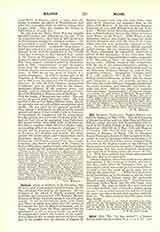

Hilduin, Abbot of St-Denis, d. November 22, 840. He was a scion of a prominent Frankish family, but the time and place of his nativity are unknown. He was educated in the school of Alcuin, acquired much erudition, and corresponded with Rabanus Maurus. Hincmar of Reims, his pupil, speaks of him with great respect. In 815 he obtained the Abbey of St-Denis near Paris; to which were added later the Abbeys of St-Germain des Pres, St-Medard in Soissons, and St-Ouen. Emperor Louis the Pious appointed him his archchaplain in 819, or, more probably, not until 822. He accompanied Louis’s son, Lothair, on his expedi-tion to Rome in 824, on which occasion the latter took part in the conflict over the election of Eugene II. Hilduin brought back with him from Rome some relics of St. Sebastian and bestowed them on the Abbey of St-Medard. In the war between Emperor Louis and his sons (830) Hilduin took the side of the latter. Thereby he lost his abbeys and was banished, first to Paderborn and then to the Abbey of Corvey (near Hoxter on the Weser). Abbot Warin of that monastery received him kindly, in return for which Hilduin presented him with the relics of St. Vitus, which thereafter were profoundly venerated in Corvey. No later than 831, however, Hilduin regained Louis’s favor. He was reinstated in the Abbey of St—Denis, whereupon he successfully undertook a reform of that monastery. A few years later (835) Emperor Louis commissioned him to write a biography of St. Dionysius of Paris, the emperor’s particular patron saint. Hilduin executed this commission, with the aid of the pseudo-Dionysius’s writings, a copy of which had been sent to the Frankish court by the Byzantine Emperor Michael II, and of other authorities (Galenus, “Areopagitica”, Cologne, 1653; P.L., CIV, 1326-28; CVI, 23-50). In his “Vita” Hilduin identified Dionysius of Paris with the Areopagite Dionysius, a view not generally accepted at that time, but which Hilduin’s biography popularized for several centuries, until Sismondi and others dispelled this error. Hilduin also helped to complete the Carlovingian “Reichsannalen”, or imperial annals.
J. P. KIRSCH

